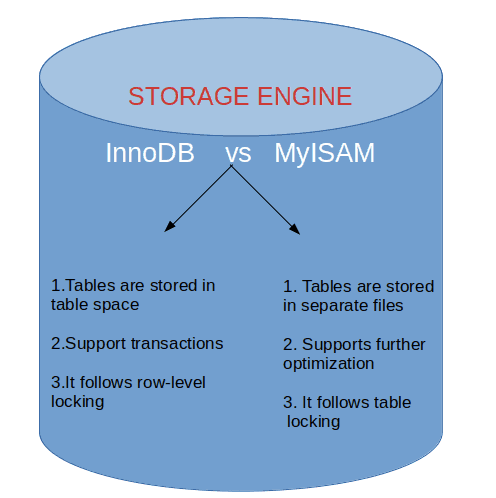InnoDB vs MyISAM performance – Which storage engine is the best?
Basically, MyISAM is faster for reads, InnoDB is faster for writes. As soon as you start introducing mixed read/writes, InnoDB will be faster for reads as well, thanks to its Row locking mechanism.
MySQL supports multiple storage engines. Among them MyISAM and InnoDB are the most widely used.
Here at Ibmi Media, as part of our Server Management Services, we regularly help our Customers to choose the right storage engine.
In this context, we shall perform an analysis of InnoDB vs MyISAM performance and see what makes them unique from each other.
A brief background about InnoDB vs MyISAM performance ?
What are these storage engines? This is the basic question to be answered before everything.
A storage engine is a software component used by DBMS for creating, reading, updating and deleting data from it.
MyISAM and InnoDB are the two most widely used but there are many other storage engines including CSV, MRGMYISAM, BLACKHOLE, etc.
Recently, one of our customers approached us with the request that he is using Percona cluster and the tables are not replicating. When checked, we found that he was using MyISAM.
So, our Experts suggested him to use InnoDB as it is the default storage engine for Percona.
Based on the requirements of our customers, our Experts suggest the best among InnoDB and MyISAM.
What is locking in MySQL?
Before moving to the comparison between InnoDB and MyISAM, let’s have a walk through this locking concept in MySQL.
MySQL exert locking in order to protect the integrity of the data stored within the databases.
Simply put, it protects the data from being accessed.
And, is necessary for ensuring the accuracy of data stored. The locking style varies in different storage engine depending on the data stored and query used.
In MyISAM table locking is used. Here, it locks the entire table even if only or two cells need to be updated or deleted.
Whereas, InnoDB locks only a range of rows while one or two cells needs to be updated or deleted.
Based on the requirement of the customer, we suggest the best as both InnoDB and MyISAM performs well.
Differences between InnoDB and MyISAM ?
MyISAM is the default MySQL storage engine. It performs well on large tables requiring vastly more read activity than write.
Because, locking the entire table is quicker than finding out which rows are locked in the table.
But, MyISAM won’t provide data integrity. Hardware failures, cancelled operations, etc cause data corruption.
Whereas, InnoDB records the data before the transactions into a system table space file.
In case of any crash, InnoDB would auto recover through the reply of those logs.
However, we can’t choose one over the other as both have their own pros and cons.
What are the pros and cons of InnoDB vs MyISAM performance?
Regarding transactions by tables InnoDB is the best as MyISAM doesn't support this. So, InnoDB is the best option for larger databases.
As it supports row-level locking inserting and updating is much faster than in MyISAM.
Whereas, MyISAM is simpler to design and create. And, is faster because of its simple structure.
Also, tables in MyISAM are stored in separate files in compressed mode, while InnoDB using system table space file.
As there is no further optimization possible in innodb, MyISAM supports more optimization.
In choosing the best among InnoDB vs MyISAM on basis of their performance, the first step is in determining if you need the features provided by InnoDB.
If not, then MyISAM is the next for consideration.
[Having trouble in choosing among InnoDB vs MyISAM? – Our Support Experts are available 24/7. ]
Conclusion
This article will guide you on the performance of InnoDB and MyISAM. MyISAM will out-perform InnoDB on large #tables that require vastly more read activity versus write activity. MyISAM's readabilities outshine InnoDB because locking the entire table is quicker than figuring out which rows are locked in the table.
InnoDB is better option while you are dealing with larger #database because it supports transactions, volume while MyISAM is suitable for small project.
InnoDB and MYISAM , are storage engines for MySQL .
InnoDB and #MYISAM differ on their locking implementation:
i. #InnoDB locks the particular row in the table, and MyISAM locks the entire MySQL table.
ii. As InnoDB supports row-level locking which means inserting and updating is much faster as compared with MyISAM.
Which storage engine is best in #MySQL:
1. InnoDB: The default option in MySQL 5.7, InnoDB is a robust storage engine that offers:
2. MyISAM: The functionality that sets MyISAM apart is its capability for:
3. NDB (or NDBCLUSTER): If a clustered environment is where your database will be working, NDB is the storage engine of choice.
This article will guide you on the performance of InnoDB and MyISAM. MyISAM will out-perform InnoDB on large #tables that require vastly more read activity versus write activity. MyISAM's readabilities outshine InnoDB because locking the entire table is quicker than figuring out which rows are locked in the table.
InnoDB is better option while you are dealing with larger #database because it supports transactions, volume while MyISAM is suitable for small project.
InnoDB and MYISAM , are storage engines for MySQL .
InnoDB and #MYISAM differ on their locking implementation:
i. #InnoDB locks the particular row in the table, and MyISAM locks the entire MySQL table.
ii. As InnoDB supports row-level locking which means inserting and updating is much faster as compared with MyISAM.
Which storage engine is best in #MySQL:
1. InnoDB: The default option in MySQL 5.7, InnoDB is a robust storage engine that offers:
2. MyISAM: The functionality that sets MyISAM apart is its capability for:
3. NDB (or NDBCLUSTER): If a clustered environment is where your database will be working, NDB is the storage engine of choice.












